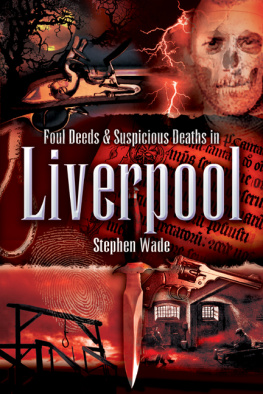
FOUL DEEDS AND SUSPICIOUS DEATHS Series
Wharncliffes Foul Deeds and Suspicious Deaths series explores, in detail, crimes of passion, brutal murders and foul misdemeanours from early modern times to the present day. Victorian street crime, mysterious death and modern murders tell tales where passion, jealousy and social deprivation brought unexpected violence to those involved. From unexplained death and suicide to murder and manslaughter, the books provide a fascinating insight into the lives of both victims and perpetrators as well as society as a whole.
Other titles in the series include:
Foul Deeds and Suspicious Deaths in Birmingham , Nick Billingham
ISBN: 1-903425-96-4. 10.99
Foul Deeds and Suspicious Deaths in Bolton , Glynis Cooper
ISBN: 1-903425-63-8. 9.99
Foul Deeds and Suspicious Deaths in Colchester , Patrick Denney
ISBN: 1-903425-80-8. 10.99
Foul Deeds and Suspicious Deaths in Coventry , David McGrory
ISBN: 1-903425-57-3. 9.99
Foul Deeds and Suspicious Deaths Around Derby , Kevin Turton
ISBN: 1-903425-76-X. 9.99
Foul Deeds and Suspicious Deaths in and around Durham , Maureen Anderson
ISBN: 1-903425-46-8. 9.99
Foul Deeds and Suspicious Deaths in Londons East End , Geoffrey Howse
ISBN: 1-903425-71-9. 10.99
Foul Deeds and Suspicious Deaths in Hampstead, Holborn & St Pancras , Mark Aston
ISBN: 1-903425-94-8. 10.99
Foul Deeds and Suspicious Deaths in Hull , David Goodman
ISBN: 1-903425-43-3. 9.99
Foul Deeds and Suspicious Deaths Around Leicester , Kevin Turton
ISBN: 1-903425-75-1. 10.99
Foul Deeds and Suspicious Deaths in Manchester , Martin Baggoley
ISBN: 1-903425-65-4. 9.99
Foul Deeds and Suspicious Deaths in Newcastle , Maureen Anderson
ISBN: 1-903425-34-4. 9.99
Foul Deeds and Suspicious Deaths in Newport , Terry Underwood
ISBN: 1-903425-59-X. 9.99
Foul Deeds and Suspicious Deaths in and Around Scunthorpe , Stephen Wade
ISBN: 1-903425-88-3. 9.99
More Foul Deeds and Suspicious Deaths in Wakefield , Kate Taylor
ISBN: 1-903425-48-4. 9.99
Foul Deeds and Suspicious Deaths in York , Keith Henson
ISBN: 1-903425-33-6. 9.99
Foul Deeds and Suspicious Deaths on the Yorkshire Coast , Alan Whitworth
ISBN: 1-903425-01-8. 9.99
Please contact us via any of the methods below for more information or a catalogue.
WHARNCLIFFE BOOKS
47 Church Street Barnsley South Yorkshire S70 2AS
Tel: 01226 734555 734222 Fax: 01226 734438
E-mail: enquiries@pen-and-sword.co.uk Website: www.wharncliffebooks.co.uk
First published in Great Britain in 2006 by
Wharncliffe Local History
an imprint of
Pen & Sword Books Ltd
47 Church Street
Barnsley
South Yorkshire
S70 2AS
Copyright Stephen Wade, 2006
ISBN 1 84563 000 9
eISBN 9781783037414
The right of Stephen Wade to be identified as Author of the Work has been asserted by him in accordance with the Copyright, Designs and Patents Act 1988.
A CIP catalogue record for this book is available from the British Library
All rights reserved. No part of this book may be reproduced or transmitted in any form or by any means, electronic or mechanical including photocopying, recording or by any information storage and retrieval system, without permission from the Publisher in writing.
Typeset in Plantin and Benguiat by Phoenix Typesetting, Auldgirth, Dumfriesshire
Printed and bound in England by Biddles Ltd, Kings Lynn
Pen & Sword Books Ltd incorporates the Imprints of Pen & Sword Aviation, Pen & Sword Maritime, Pen & Sword Military, Wharncliffe Books, Pen and Sword Select, Pen and Sword Military Classics and Leo Cooper
For a complete list of Pen & Sword titles please contact
PEN & SWORD BOOKS LIMITED
47 Church Street
Barnsley
South Yorkshire
S70 2AS, England
E-mail: enquiries@pen-and-sword.co.uk
Website: www.pen-and-sword.co.uk
Acknowledgements
Thanks are due to Laura Carter who did the line drawings, to my friends and contacts in Liverpool who have helped with anecdotes, and to arguably the most dedicated true crime writer from Merseyside, Richard Whittington-Egan.
Acknowledgements for permission to use pictorial material are due to Liverpool Record Office and to Liverpool Central Library. For much of the sociological data, the survey done by the University of Liverpool in 1934 has been invaluable.
I have to thank Clifford Elmer Books for permission to use the Wallace case cover and the Maybrick illustration. Andy Tennick did several drawings also and talk about some of the cases with local writers was very valuable.
Finally, thanks are due to Liverpool Record Office for permission to reproduce images of Mr Aspinall, Silvester Court and Kirkdale Gaol, used in the Flanagan and Higgins murder case.
Introduction
For much of the period covered in this book, the city of Liverpool was like every other major city energized by the Victorian boom in industry and trade: a place with massive success and equally massive problems which came along with that. The Liverpool police force, formed in 1836 and lasting until 1974, was going to have its work cut out to keep on top of the urban problems it faced. Its initial manpower was 390 men; they would be busy, and would have to face all kinds of crime, some of it new, along with the new modes of life that came along with developing industries.
The new constabulary force in its central office had one indoor Superintendent or Commissioner, assisted by two clerks, and eight constables. In the day and night patrol there were over 300 men, including twenty-four inspectors. Forty-two fire police also came along with this new force.
But of course, many of the troubles of the city were those of a past age, still surviving. One officer lost his life in 1853 at the hustings. Constable Sunderland was stabbed to death while trying to arrest a voter. We know very little else about him, and his story will be one that is lost in this chronicle. Other events have had to be left out, for reasons of space. The 1903 religious disturbances, for instance, in which a crowd had a mass brawl at Old Swan. Even more massive in scale is the whole business of juvenile delinquency. In 1916, the Liverpool Education Committee, appointed in a state of alarm over the number of young offenders appearing at the City Juvenile Court, reported that the punishment of whipping should be maintained. Of course, many fathers were away at war, but discipline had to be enforced, and justices were given the power to impose whipping on boys up to the age of fourteen.
But much more could be written on this topic; Liverpool was arguably the place of the reformatory. In the nineteenth century the city had the Clarence reformatory school ship for boys, off New Ferry. This was a battle ship that had been built in 1827. In 1884, it was to be burnt out in an arson attack by six of the boys. It was replaced by the Royal William , but that experienced a mutiny and a burning. Boys were dispersed across the land, many to the Whitwick reformatory in Leicestershire. In 1856 it was the largest in the country, and took many delinquent boys from Liverpool.
After the Juvenile Offenders Act of 1847, young offenders could be tried at summary courts, and then, in 1854, reformatories began to replace prisons as their destination. The rough, tough Liverpool lads who went to Whitwick caused such a serious riot in 1863 that eight constables were called out. One constable from Shepsted was seriously injured. That saga would be a book on its own, and any writing on Liverpool tends to have that effect: the subject expands, so great is the narrative potential of this complex yet wonderful city. It has the reputation of being a creative, bustling place, on the edge of Britain, looking across to America and Ireland. Its complexity is such that it has always had a volatile mix of races and religions in its demography. In the midst of all this, naturally, there had been crime.
Next page
















